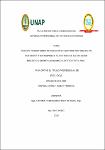| dc.contributor.advisor | Reátegui de Kahn, Carmen Teresa | |
| dc.contributor.author | Garay Trigoso, Cinthia Karoly | |
| dc.date.accessioned | 2022-09-21T17:30:37Z | |
| dc.date.available | 2022-09-21T17:30:37Z | |
| dc.date.issued | 2022 | |
| dc.identifier.uri | https://hdl.handle.net/20.500.12737/8349 | |
| dc.description.abstract | The study was carried out with the purpose of knowing the parasitic indices of gastrointestinal helminths in rodents and wild marsupials of the Quebrada Blanco Biological Station, located on the right bank of the Quebrada Blanco, a tributary of the Tahuayo River, district of Fernando Lores, Loreto-Peru. . The rodents and marsupials were collected using 268 traps (120 Sherman, 120 hit and 28 Tomahawk) (Romero, 2017). The sample consisted of the digestive tracts of 25 rodents: 20 Proechimys sp., 3 Oecomys sp., 2 Scolomys sp. and 8 marsupials: 6 Marmosops sp. and 2 Monodelphis sp.; preserved in 10% formalin. The search for adult worms was carried out by direct observation of the gastrointestinal content through a stereoscope; internal organs were separated and rinsed with lactophenol for microscopic identification (Kennedy, 2016). Seven gastrointestinal helminths were identified: Spirura guianensis Physaloptera sp., Syphacia sp., Aspidodera sp. and Trichuris sp.,Trichostrongylidae y Anoplocephallidae and an unidentified metacestode. The parasitic indices were: general prevalence of gastrointestinal helminths was high for both groups, 68% in rodents and 87.5% in marsupials. In rodents, Trichostrongylidae 1 registered average prevalence with 52%, Moderate Average Abundance with 79.44 helminths/host, Average Intensity was moderate with 152.76 helminths/host parasitized by. In marsupials, Spirura guianensis reached high prevalence (75%), and the unidentified cestode, low Mean Abundance with 43,625 helminths/host and moderate Mean Intensity with 174.5 helminths/host were recorded. When comparing the parasitic indices between rodents and marsupials, the Sörensen index was low (16%), corroborating the significant difference found (ANOSIM, p=0.001). Monoparasitism prevailed with 37.5% in marsupials and 28% in rodents. The small intestine was more parasitized with 64.66% in rodents and 11% in marsupials. In conclusion, the parasitic indices in rodents and marsupials at the Quebrada Blanco Biological Station differ by host group. | en_US |
| dc.description.abstract | El estudio se realizó con la finalidad de conocer los índices parasitarios de helmintos gastrointestinales en roedores y marsupiales silvestres de la Estación Biológica Quebrada Blanco, ubicado al margen derecho de la Quebrada Blanco, un afluente del río Tahuayo, distrito de Fernando Lores, Loreto-Perú. Los roedores y marsupiales fueron colectados utilizando 268 trampas(120 Sherman, 120 de golpes y 28 Tomahawk)(Romero, 2017). La muestra estuvo conformada por los tractos digestivos de 25 roedores: 20 Proechimys sp., 3 Oecomys sp., 2 Scolomys sp.y 8 marsupiales: 6 Marmosops sp. y 2 Monodelphis sp.; conservados en formol al 10%. La búsqueda de gusanos adultos se realizó por observación directa del contenido gastrointestinal al estereoscopio; se separaron y aclararon los órganos internos con lactofenol para su identificación al microscopio (Kennedy, 2016). Se identificaron 7 helmintos gastrointestinales: Spirura guianensis, Physaloptera sp., Syphacia sp., Aspidodera sp., Trichuris sp., Trichostrongylidae y Anoplocephallidae y un metacestodo no identificado. Los índices parasitarios fueron: prevalencia general de helmintos gastrointestinales fue alta para ambos grupos, 68% en roedores y 87.5% en marsupiales. En los roedores, Trichostrongylidae 1 registro prevalencia media con 52%, Abundancia Media moderada con 79.44 helmintos/hospedero, Intensidad Media fue moderada con 152.76 helmintos/hospedero parasitado por. En marsupiales, Spirura guianensis alcanzo alta prevalencia (75%), y el cestodo no identificado registraron baja Abundancia Media con 43.625 helmintos/hospedero y moderada Intensidad Media con 174.5 helmintos/hospedero. Al comparar los índices parasitarios entre roedores y marsupiales se registró el índice de Sörensen fue baja (16%) corroborando con la difierencia significativa encontrada (ANOSIM, p=0.001). Predominó el monoparasitismo con 37.5% en marsupiales y 28% en roedores. El intestino delgado estuvo más parasitado con 64.66% en roedores y 11% en marsupiales. En conclusión, los índices parasitarios en roedores y marsupiales de la Estación Biológica Quebrada Blanco difieren por grupo de hospedero. | es_PE |
| dc.format | application/pdf | es_PE |
| dc.language.iso | spa | es_PE |
| dc.publisher | Universidad Nacional de la Amazonía Peruana | es_PE |
| dc.rights | info:eu-repo/semantics/openAccess | * |
| dc.rights.uri | https://creativecommons.org/licenses/by/4.0/ | * |
| dc.subject | Helmintos | es_PE |
| dc.subject | Roedores | es_PE |
| dc.subject | Marsupiales | es_PE |
| dc.subject | Índice | es_PE |
| dc.title | Índices parasitarios de helmintos gastrointestinales en roedores y marsupiales silvestres de la Estación Biológica Quebrada Blanco, Loreto-Perú, 2018 | es_PE |
| dc.type | info:eu-repo/semantics/bachelorThesis | es_PE |
| thesis.degree.discipline | Ciencias Biológicas | es_PE |
| thesis.degree.grantor | Universidad Nacional de la Amazonía Peruana. Facultad de Ciencias Biológicas | es_PE |
| thesis.degree.name | Biólogo(a) | es_PE |
| dc.subject.ocde | https://purl.org/pe-repo/ocde/ford#3.03.07 | es_PE |
| renati.author.dni | 74150192 | |
| renati.advisor.orcid | https://orcid.org/0000-0001-5636-2359 | |
| renati.advisor.dni | 05267255 | |
| renati.type | https://purl.org/pe-repo/renati/type#tesis | es_PE |
| renati.discipline | 511206 | es_PE |
| renati.level | https://purl.org/pe-repo/renati/level#tituloProfesional | es_PE |
| renati.juror | Cachique Pinche, Mirle | |
| renati.juror | Sánchez Vela, Carol Margareth | |
| renati.juror | Pezo Lozano, Etersit | |
| dc.publisher.country | PE | es_PE |


